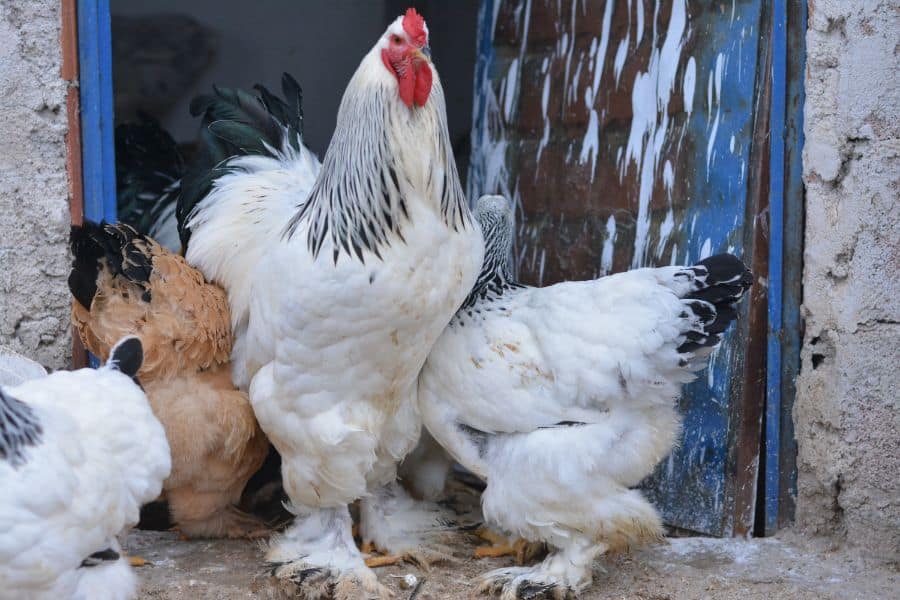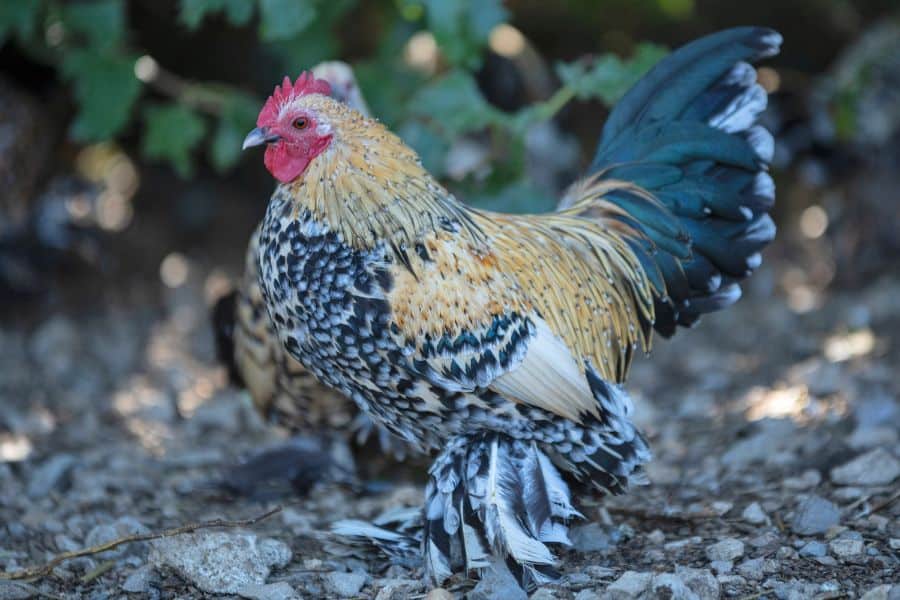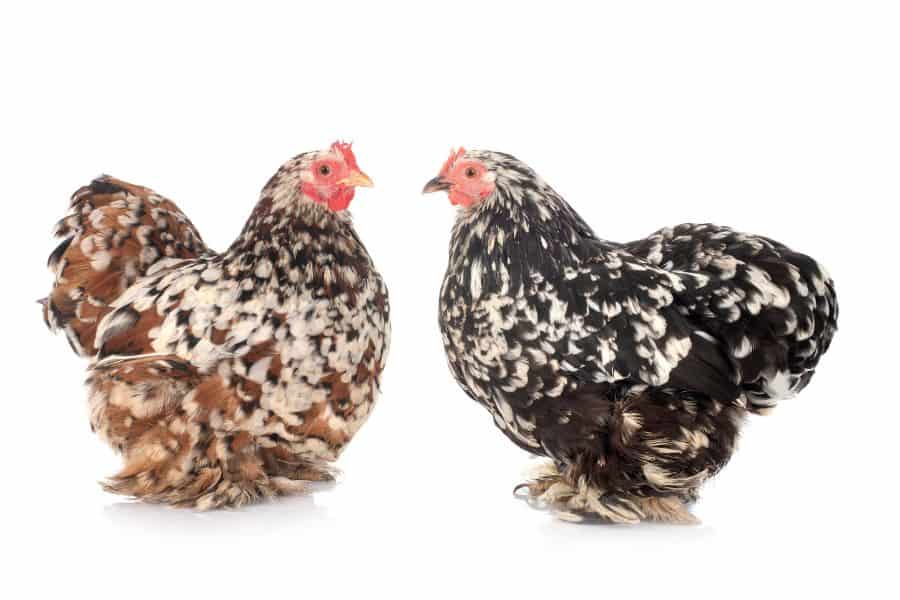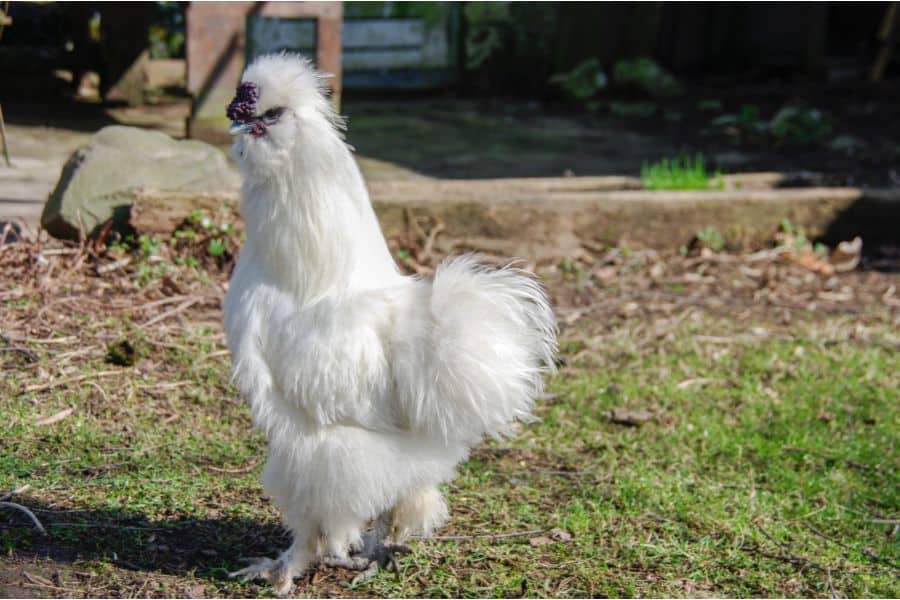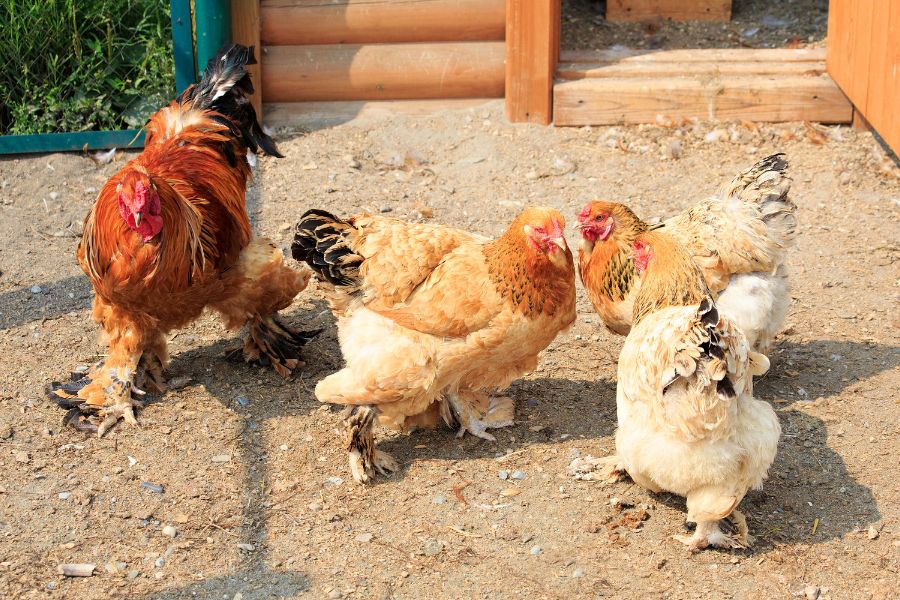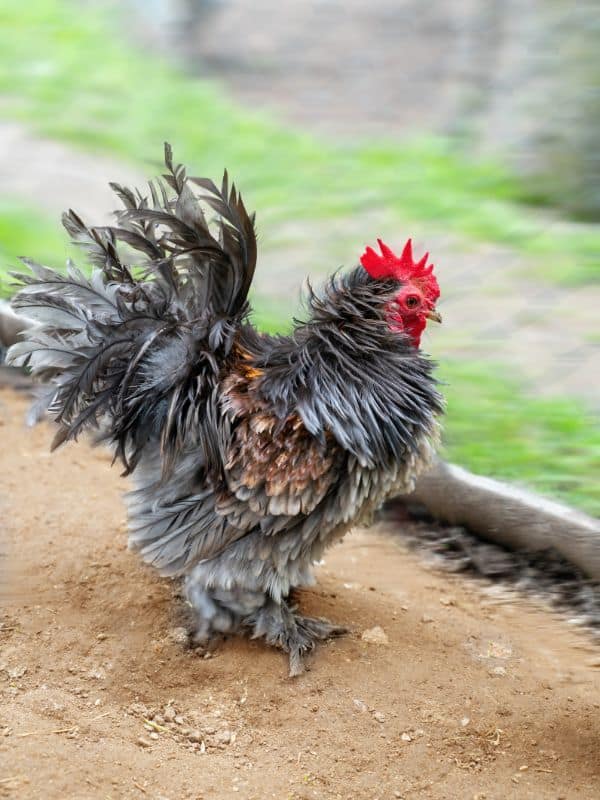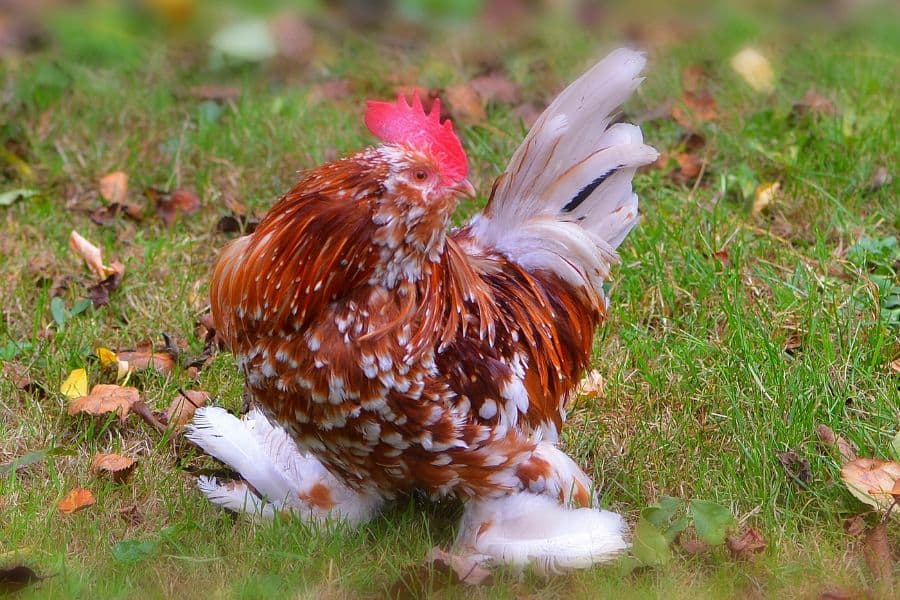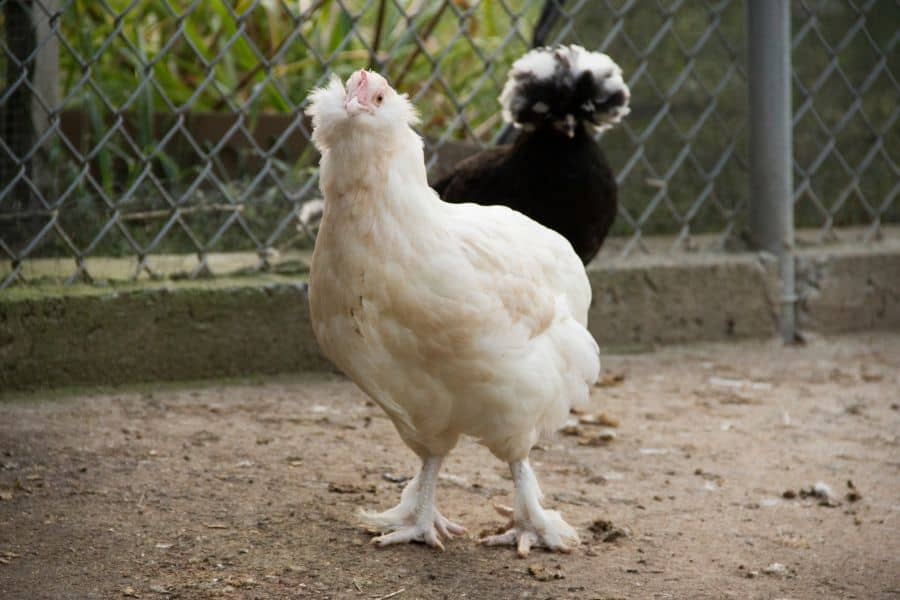Did you know that the number of chickens worldwide is more than triple the human population? And of these 25+ million chickens, only a handful exhibit the uncommon foot feathering trait seen in various bird species.
Of the hundreds of recognized chicken breeds out there, only a dozen of them have been marked as chickens with feathered feet: Marans, Brahma, Sultan, Booted Bantam, Cochin Bantam, Silkie, Frizzle, Croad Langshan, Barbu d’Uccle, Cochin, Malaysian Serama, and Faverole.
The unique trait offers a touch of uniqueness and beauty, making these breeds popular for exhibition and ornamental purposes. Some have feathers on their feet, legs, and toes, while others only have feathers on their feet or legs.
Read on to dive into a complete guide of feathered feet chickens and how they came to be. Learn of the various traits these chickens have, their varying colors, and what purposes they are bred for. Also, you can learn how to properly care for them to keep them looking neat for longer.
Why Do Chickens Have Feathers On Their Feet?
Feathered feet are just one of the many variations that can be found in the diverse world of chicken breeds.
Feathering, known scientifically as Ptilopody, is a genetic trait that is seen in only a handful of chickens and other bird species. It is the trait that causes the growth of feathers on the feet, legs, toes, and even the outer toes of the birds.
Feathered feet develop from selective breeding and natural genetic inheritance across many generations. Many believe that the feathered feet were developed to only serve as aesthetic appeal, but we now know they have some practical purposes.
Feathered feet provide additional insulation, helping the chickens stay warm in colder seasons or in chilly climates.
The feathers also offer some protection against injuries, such as scratches or pecking, and may help in navigating through rough terrains. This functional aspect adds to their overall appeal.
Ptilopody relies on two genes: Pitx1, responsible for the development of forelimbs, and Tbx5, responsible for the development of hindlimbs in chickens.
This implies that combining both genes helps include feathers and a larger leg bone in feathered feet chickens. The unique leg muscular structure is wing-like, causing the breeds to have varying strengths in their legs compared to scaled-leg chickens.
Despite their attractive appearance, feathered feet chickens are more likely to suffer from limping, leg mites, dirt accumulation, feather damage, and frostbites.
Top 11 Common Chickens With Feathers On Their Feet
Distributed worldwide, feathered feet chickens come in all shapes, sizes, and colors. They all serve different purposes, from egg-producing flocks to showing birds and meat production. Despite their various differences, it is fair to say they are all drop-dead gorgeous!
1. Marans
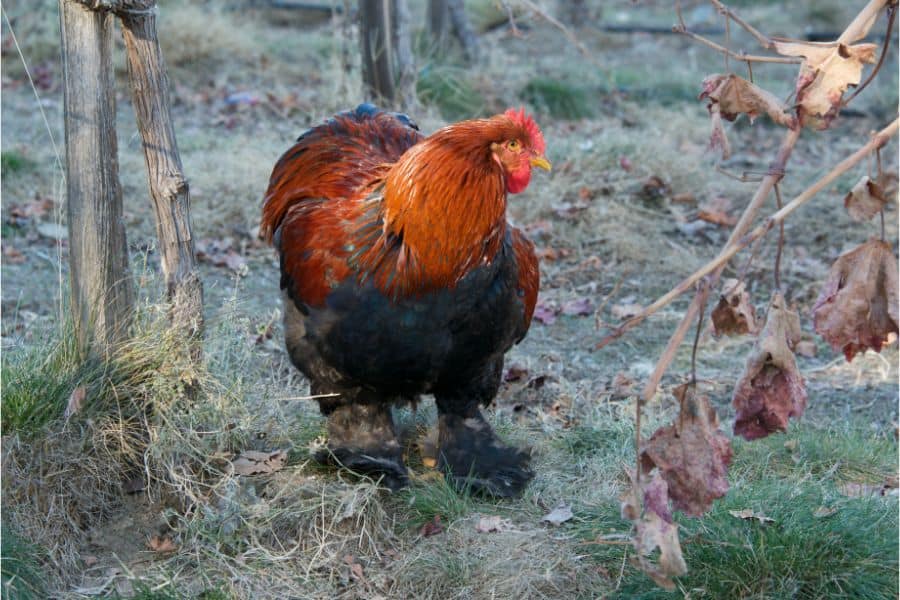
| Origins | South-Western France |
| Primary use | Egg & Meat |
| Egg Production in A Year | 150 – 200 |
| Egg Color | Dark brown |
| Average Weight | 6 – 8 lbs. |
| Feather Colors & Varieties | White, black, black copper, blue copper, salmon, silver, blue, blue Wheaten, Golden cuckoo, Columbian, Wheaten, and Brown Red |
Marans come in a wide range of colors and varieties, with the Cuckoo Marans and Black Copper Marans being the most popular. It is a dual-purpose chicken breed reared for its dark brown eggs and as a source of meat.
Originating from the town of Marans in France, the Marans chickens are famous for their beautiful feathered feet with gorgeous feather colors, including black, blue, golden, and copper.
Their feathered feet aside, the rich brown-colored eggs are their most unique feature since only one other breed produces such vibrant eggs, the Penedesenca of Catalonia.
Marans are mainly distributed in the United States and France regions today and are still being used for eggs and meat. However, it is important to note that only French Marans have feathered feet; English Marans have featherless legs and feet.
Their attractive and functional feet feathers make Marans an excellent addition to any backyard flock. However, they are harder to care for and need extra attention.
Like other feathered feet birds, you will need to pay attention to their cleanliness to avoid muddy feathered feet. Also, look out for leg mites and frostbites, which are common in feathered legs.
In the company of non-feathered chickens, it is important to ensure the Marans aren’t bullied since the other breeds tend to pluck their feet and leg feathers, leading to breeds and painful feather plucks.
2. Brahma
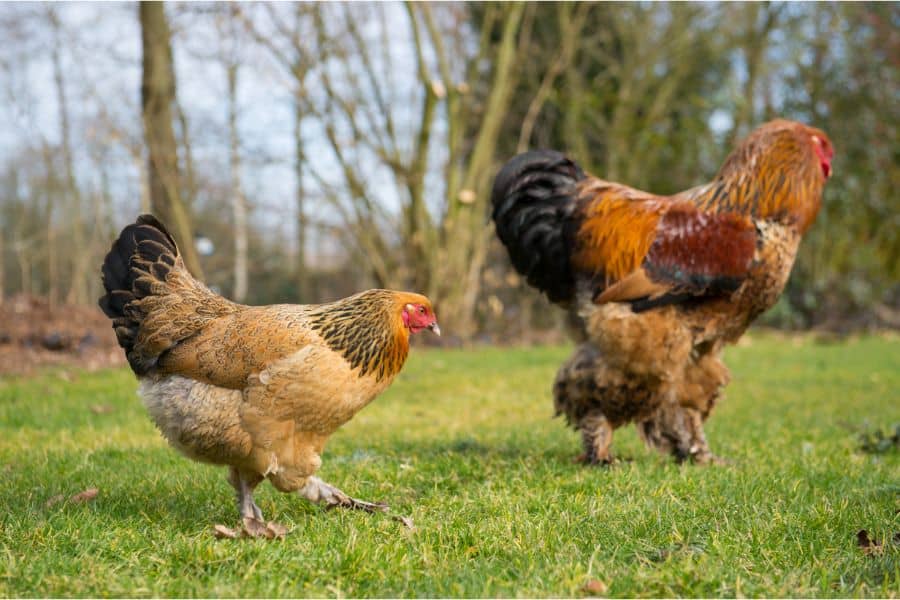
| Origins | United States |
| Primary use | Egg and Meat |
| Egg Production in A Year | 150 – 200 |
| Egg Color | Brown |
| Average Weight | 10 – 12 lbs. |
| Feather Colors & Varieties | Buff, dark, light, black, white |
Brahma chicken with feathered feet is an American breed that came about due to the importation of chickens from Shanghai in China during the late 1800s and early 1900s.
They are known for their large size and big eggs, and in fact, for a period of time between the mid-1850s and 1930, Brahmas were considered the leading meat breed in the United States.
Brahmas, known for their calm disposition and impressive size, possess feathered feet that enhance their majestic appearance. These large, dual-purpose birds feature downy plumage on their shanks and toes, providing both insulation and a regal flair.
Their primary purpose is egg production since they lay larger, medium-brown eggs. Most eggs are produced between October and May, making them heavy winter layers.
Brahma chickens are a great choice if you want feathered legs and heavy layers. For the most profit, pick a Brahma roaster that is 8 months old.
However, with their large size comes their higher demand for food, eating at least twice as much as the average chicken. They are also susceptible to mites and lice like other feathered-leg chickens, and their feet get irritated quickly if not cleaned regularly.
3. Sultan
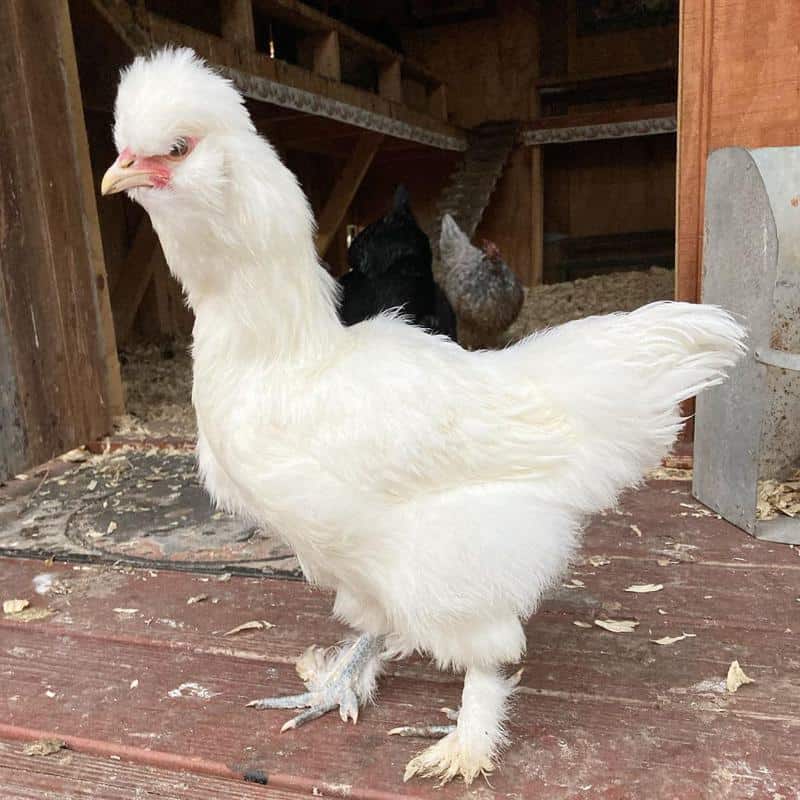
| Origins | Turkey |
| Primary use | Exhibition/Ornamental |
| Egg Production in A Year | 50 – 80 |
| Egg Color | White |
| Average Weight | 5 – 7 lbs. |
| Feather Colors & Varieties | Blue, white, black, |
Also known as Serai Taook in Turkey, the Sultans are true royalty in the chicken world, with their majestic feathered feet and crested heads. Originating from Turkey, these birds are prized for their elegant appearance and friendly nature.
Feathering goes past their legs and feet and spreads throughout their five toes. This beautiful plumage made them living ornaments in the Ottoman sultanate’s gardens, which is why many poultry enthusiasts keep them for show.
Apart from the unique feathering, Sultans also feature a variety of colors, a beard, larger crests of feathers on their heads, and a lovable, gentle demeanor.
Their calm temperament makes them a target for bullying which is something you will have to pay more attention to when caring for them.
Sultans are primarily exhibition breeds since they are smaller and lighter and produce slowly, with about 50 eggs per year.
4. Booted Bantam
| Origins | Europe |
| Primary use | Exhibition/Ornamental |
| Egg Production in A Year | 160 |
| Egg Color | White/Tinted |
| Average Weight | 1.9 – 2.9 lbs. |
| Feather Colors & Varieties | Grey, lavender, blue, white, black, gold, silver, porcelain, cuckoo, buff |
Booted Bantams, or Dutch booted bantams, are small but big in personality. They are among the rarest and oldest Bantam breeds worldwide, with 6-inch long feathers. Hence the name ‘booted’ Bantams – the feathering on their lower legs and feet resemble little boots.
These charming birds come in various colors and patterns, making them an eye-catching addition to any flock. And since they are small with little meat value and smaller eggs, Booted Bantams are primarily kept as pets for ornamental purposes.
Their demeanor is calm and friendly, which makes them a target for bullying, especially when kept in the same flock as larger, more aggressive chickens.
5. Cochin Bantams
| Origins | China |
| Primary use | Exhibition and Egg |
| Egg Production in A Year | 120- 160 |
| Egg Color | White/Cream |
| Average Weight | 1.2 – 1.9 lbs. |
| Feather Colors & Varieties | Grey, lavender, blue, white, black, gold, silver, porcelain, cuckoo, buff, barred, Columbian, mottled |
Cochin Bantams, originally from Peking, China, and bred in Europe, are beloved for their fluffy feathered feet, which give them a delightful appearance.
These small and docile birds are available in various colors and are a popular choice for backyard chicken keepers and exhibition enthusiasts alike. They make ideal pets, but it is important to note that cocks can be aggressive and defensive once they are sexually mature.
Due to their small size, they are not productive egg layers, and their meat is not a well sort out aspect of the feathered chickens.
The main challenge of caring for Cochin Bantams is ensuring their foot feathers are not soiled so as not to cause foot rot. In many cases, you may need to trim their feathers, not only to keep them clean but also to improve fertility.
Editor’s Note: Cochin Bantams are also called Pekin Bantams (Cochin pekin bantams). They are not to be mistaken for the large 5 – 6 lbs. Cochins. Cochins are not a bantam breed but rather a very large breed of chicken with few similar characteristics as the Pekin/Cochin/Cochin Pekin Bantam.
6. Silkie Bantam
| Origins | China |
| Primary use | Exhibition |
| Egg Production in A Year | 120 |
| Egg Color | Cream |
| Average Weight | 4 – 6 lbs. |
| Feather Colors & Varieties | Black, brown, blue, gray, partridge, white, buff |
Silkies are renowned for their unique appearance, characterized by their soft, fur-like feathers and, of course, their feathered feet. These charming birds possess an unmistakable elegance, with the feathering extending down to their toes.
They have a prominent crest of feathers on top of their heads, which gives them a stylish and somewhat regal look. Additionally, they possess a muff and beard, which are fluffy feathering under the beak and around the sides of the face.
These features contribute to their overall enchanting appearance. They are also adored for their gentle nature and make excellent pets.
While Silkies are not the most prolific egg layers, they do provide a modest supply of small to medium-sized eggs. On average, a Silkie hen may lay around 100 to 120 eggs per year. However, they are not commonly kept for their egg-laying abilities but rather for ornamental and pet purposes.
7. Cochin
| Origins | China |
| Primary use | Exhibition/Ornamental, Egg, Meat |
| Egg Production in A Year | 100 – 120 |
| Egg Color | Brown |
| Average Weight | 5 – 6 lbs. |
| Feather Colors & Varieties | Black, birchen, white, red, blue, brown, |
Unlike the small Pekin/Cochin/Cochin Pekin Bantams, the Cochins are among the largest feathered feet Bantams, characterized by their abundant plumage and fluffy appearance. They are also harder and more expensive to keep, with a less popular fan base compared to Bantam Cochins.
These gentle giants boast feathering that extends from their heads down their shanks and toes, giving them an adorable and captivating appeal.
They produce medium-sized eggs, but their products can get slow, which makes them good choices for pets and for exhibition purposes. Their large sizes are good for breeding broilers.
8. Frizzle
| Origins | N/A |
| Primary use | Exhibition, Eggs |
| Egg Production in A Year | 160 |
| Egg Color | White or Tinted |
| Average Weight | 5 – 8 lbs. |
| Feather Colors & Varieties | Blue, brown, cuckoo, black, white |
The docile and gentle, quiet Frizzle is a distinctive breed with feathers that curl outward, giving them a frizzled or ruffled appearance.
Frizzles are among the many species whose origins are harder to track down. Many believe they come from Asia, India, or Egypt, but it has not yet been confirmed how they came to be.
Their feathered legs include smooth feathers with about 75% frizzled feathers ensuring their offspring get frizzled feathers too. However, the frizzle gene deteriorates quickly, and some offspring end up with bald spots.
Feathered feet further accentuate their uniqueness, making them a great choice for exhibition purposes. Since they are primarily bred for the show ring, these bantam varieties are much more common in larger types, and their eggs are smaller in size.
Adult males are heavier at about 8 pounds compared to female Frizzles, who happen to weigh between 5 – 6 pounds. Regardless of their size, Frizzles are friendly and fairly submissive, which can make them prone to bullying. Keeping them with similarly tempered chicken like Silkies and Cochins is best.
9. Croad Langshan
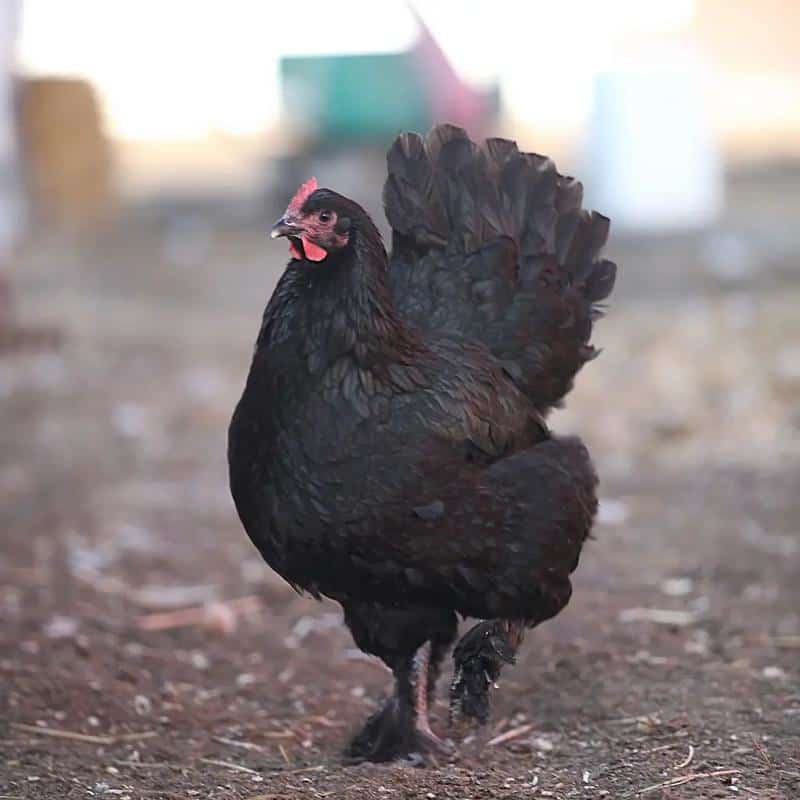
| Origins | China |
| Primary use | Ornamental, Egg Production, Meat |
| Egg Production in A Year | 120 – 160 |
| Egg Color | Plum or different shades of brown |
| Average Weight | 6 – 8 lbs. |
| Feather Colors & Varieties | Black |
Croad Langshans, originating from China, are renowned for their glossy black/iridescent green sheen feathers and feathered feet. The breed’s name comes from the village of Langshan in the Hebei province of northern China, where it was first developed.
The large and robust bird possesses a calm and friendly demeanor. Despite their tall stature, Croad Langshans have fewer feathers on their legs compared to other feathered feet chickens on this list.
Its excellent egg-laying productivity makes it a profitable breed, and its large size makes it a dual-purpose bird that is also kept for its meat production.
10. Barbu d’Uccle
| Origins | Belgian breed |
| Primary use | Ornamental |
| Egg Production in A Year | 100 – 120 |
| Egg Color | Tinted/Cream |
| Average Weight | 1.4 – 2 lbs. |
| Feather Colors & Varieties | Black, golden, blue, blue quail, white, mottled, porcelain |
Barbu d’Uccles, also known as Belgian d’Uccles or Belgian Bantam, are pint-sized bearded bantam chickens with feathered feet that add to their gorgeous charm. It is the third most common true bantam chicken in Belgium.
With just four toes, the Barbu d’Uccles only has one feathered toe, the outer one, while the rest of its leg is filled with feathers.
Available in various color varieties, these birds possess a distinctive beard and a playful disposition, making them a delightful addition to any flock. They have a low posture and feature a single comb instead of a rose comb.
Due to the small size of their eggs, Barbu muscles are regarded as pets and ornamental chickens.
Related: Mille Fleur d’Uccle
11. Faverole
| Origins | France |
| Primary use | Egg & Meat production |
| Egg Production in A Year | 150 – 240 |
| Egg Color | Tinted, pink tint, light brown |
| Average Weight | 6.5 – 8 lbs. |
| Feather Colors & Varieties | Salmon and white |
Faverole chickens are fluffy beauties with pinkish-white feathery shanks and toes. The feathering on their shanks and outer toes adds to their charm and distinguishes them from other chicken breeds.
They are medium-sized with beards, deep compact bodies, and a single red comb. With five toes on each foot, Faverole also has reddish eyes, complimenting their white or salmon feathery appearance.
Faverole chickens have a docile nature, making them ideal pets, but since they produce many eggs quickly, they are mostly kept as egg-production flocks. Their large sizes also make them ideal for meat production as broiler sets.
Related:
Conclusion
Chickens with feathered feet, such as the Marans, Pekin Bantam, Silkies, and Faverole breeds, captivate enthusiasts with their gorgeous and striking appearance. Most are kept as ornamental pets, but the largest and high-production flocks tend to thrive as egg-laying breeds.
The feathering trait is a special trait that adds to their aesthetic appeal and offers functional benefits like insulation and protection.
Whether you are a poultry enthusiast or appreciate the beauty of these extraordinary birds, chickens with feathered feet will leave a lasting impression on any flock.
